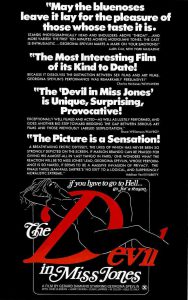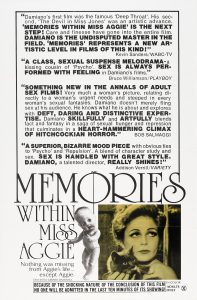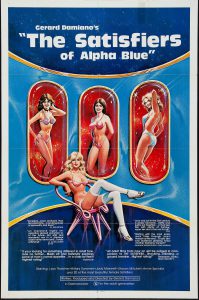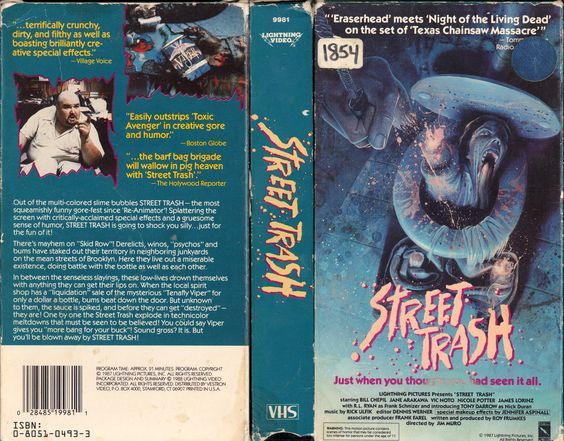Legacy of Satan (1974) by #GerardDamiano
w/ #JohnFrancis #LisaChristian #ChristaHelm #SandraPeabody
A satanic cult chooses an unwitting young girl as its new queen.
"See the unholy feast of the damned!"#Horror #Satan#NotQuiteClassicCinema pic.twitter.com/gi4opOnZTf
— Angus Kohm (@AngusKohm) December 19, 2020
In the world of adult cinema, Gerard Damiano is a legend. Or at least he should be, if for no other reason than he directed the notorious Deep Throat (1972). Sadly, one of the points that the documentary Inside Deep Throat (2005) touches on is that the kids today don’t really know who Damiano is – or at least they’ve never seen Deep Throat. And I’m talking about the kids who work in the adult film industry. This would be akin to the biggest Hollywood stars of today never having seen Citizen Kane (1941), or maybe Casablanca (1942) – which may, sadly, also be true.
I recommend watching Inside Deep Throat to get a sense of what an unbelievable phenomenon Deep Throat really was – and to learn about an important piece of pop culture history. Aside from that, it’a a darn entertaining documentary, and a story that will likely surprise you more than once.
I’m going to go out on a limb here and say that Gerard Damiano was a good filmmaker. Some may have a hard time believing that of a man who mainly worked in hard core adult cinema, but at that time making X-rated films was not that different from making any kind of genre films. They were shot on film, had real stories, and were ultimately shown in real movie theatres. And plenty of mainstream filmmakers got their start making adult movies. Abel Ferrara, Wes Craven, Lloyd Kaufman and William Lustig all made at least one X-rated movie. Other serious-minded filmmakers found success is the adult film industry and remained there (or got stuck there, in some cases). Damiano, I suspect, is one of them.
Aside from Deep Throat, which was a massive success but not his best work, Damiano made acclaimed X-rated films such as The Devil in Miss Jones (1973), Memories Within Miss Aggie (1974), The Story of Joanna (1975), Odyssey: The Ultimate Trip (1977) and The Satisfiers of Alpha Blue (1981). Each of these films was well made, and seemed to be fueled by more creative ambition than the average adult movie. It’s not clear to me whether Damiano would have liked to cross over into making mainstream movies, or if he simply believed that that hardcore erotic cinema would (and should) one day merge with the mainstream and become the new mainstream. He can be seen lamenting the demise of serious adult cinema in Inside Deep Throat, and it’s hard not to agree with him.
Legacy of Satan (1974) is unique in Damiano’s filmography, as it is not an x-rated movie. I’ve heard differing theories about this. Some people feel that Damiano filmed an x-rated version, which was then edited by the distributor to create an R-rated horror film that could be sent out with Andy Milligan’s Blood (1973). This is a provocative theory, and there certainly have been X-rated films which were distributed in both “hard” and “soft” cuts. But I don’t think that it could be true in this case. First of all, there are no x-rated performers in Legacy of Satan. Damiano had already made Deep Throat, and other films like The Magical Ring (1971), so he certainly knew actors who were experienced in hard core sex films. If he had intended Legacy of Satan to be hard core, surely he would have cast some actors who had experience with that.
The main character of Maya is played by Lisa Christian, and this is her only credit on the IMDb. In fact, many of the actors in this movie have no other credits (or very close to it). John Francis, who plays Dr. Muldavo, has a respectable list of mainstream credits, including TV shows like Get Smart (1966-1969) and The Mary Tyler Moore Show (1970-1977). It seems unlikely that he would have suddenly decided to appear in an x-rated movie.
Christa Helm, who played “The Blond Blood-farm” in Legacy of Satan, was an aspiring young actress, who appeared on Starsky and Hutch (1975–1979) and Wonder Woman 1975–1979). She was murdered in 1977, at age 27, and that crime has never been solved.
Sandra Peabody is most famous for starring in Wes Craven’s The Last House on the Left (1972). She also appeared in some soft core films like Voices of Desire (1972) and The Filthiest Show in Town (1973). Perhaps that makes her the most likely candidate to star in a hard core film, but it appears as if she never did. And she only makes a brief cameo in Legacy of Satan as one of the cult members.
The other theory about Legacy of Satan is that Damiano had intended to make an x-rated film, but then changed his mind and rewrote the script as a pure horror film. This seems, to me, more likely than the other theory, but I do wonder why people think that Damiano couldn’t have just decided to make a horror film in the first place?
Ultimately, none of this matters. Damiano has left us with a straight up horror film about a satanic cult. It only runs 68 minutes, which might be why some people think there is some missing hard core footage out there somewhere. I must admit that there were a couple of moments where the film seemed to have been edited (or censored), but I can’t find a longer cut of the film anywhere. My guess is they made a few trims back in the day, and the uncut version never got released. I suspect that all we are missing is a few seconds of nudity that made someone nervous, or some censor scissor-happy. But I guess we’ll never know.
Legacy of Satan is not a great film. It’s reputation is that it is terrible. The soundtrack music in particular seems to inspire a lot of negative comments. My experience was somewhat more positive than the average, it seems. I kind of liked the strange, dissonant, primitive synth score. People say it’s irritating, or an assault on the ears, but maybe that was the point, to make us uncomfortable and unnerve us. Whatever the case, I found it charming.
The visuals and atmosphere are pretty good. There are a few moments of artistic beauty. The problem is that you have to have a lot of patience for a story that doesn’t move along very quickly. And, ultimately, it does feel a bit like something is missing. Perhaps the rumoured (but likely non-existent) hard core (or at least more graphic soft core) sex scenes would have done the trick to keep people more engaged. As it is, Legacy of Satan seems to lack some of the creative spark that makes Damiano’s adult movies some of the most admired of the golden age.
Still, Legacy of Satan is a must see for fans of Damiano who are curious about what he might have been like as a non-adult filmmaker. It is also a must see for fans of extremely low budget, early ’70s Satanic horror films. It is unlikely to be the best example that you have ever encountered, but it should provide enough diversion for 68 minutes of your time. It is the kind of #NotQuiteClassicCinema that would work well as the third or fourth feature of an all night movie marathon on a #FridayNightAtTheHomeDriveIn. I’m not sure if it will get many repeat screenings at my home drive-in, but I’m glad that I got a chance to see it, at least once.





